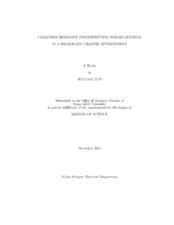| dc.description.abstract | Digital fingerprinting is a method by which a copyright owner can uniquely
embed a buyer-dependent, inconspicuous serial number (representing the fingerprint)
into every copy of digital data that is legally sold. The buyer of a legal copy is
then deterred from distributing further copies, because the unique fingerprint can be
used to trace back the origin of the piracy. The major challenge in fingerprinting is
collusion, an attack in which a coalition of pirates compare several of their uniquely
fingerprinted copies for the purpose of detecting and removing the fingerprints.
The objectives of this work are two-fold. First, we investigate the need for robustness
against large coalitions of pirates by introducing the concept of a malicious
distributor that has been overlooked in prior work. A novel fingerprinting code that
has superior codeword length in comparison to existing work under this novel malicious
distributor scenario is developed. In addition, ideas presented in the proposed
fingerprinting design can easily be applied to existing fingerprinting schemes, making
them more robust to collusion attacks.
Second, a new framework termed Joint Source Fingerprinting that integrates the
processes of watermarking and codebook design is introduced. The need for this new
paradigm is motivated by the fact that existing fingerprinting methods result in a
perceptually undistorted multimedia after collusion is applied. In contrast, the new
paradigm equates the process of collusion amongst a coalition of pirates, to degrading
the perceptual characteristics, and hence commercial value of the multimedia in question.
Thus by enforcing that the process of collusion diminishes the commercial value
of the content, the pirates are deterred from attacking the fingerprints. A fingerprinting
algorithm for video as well as an efficient means of broadcasting or distributing
fingerprinted video is also presented. Simulation results are provided to verify our
theoretical and empirical observations. | en |


